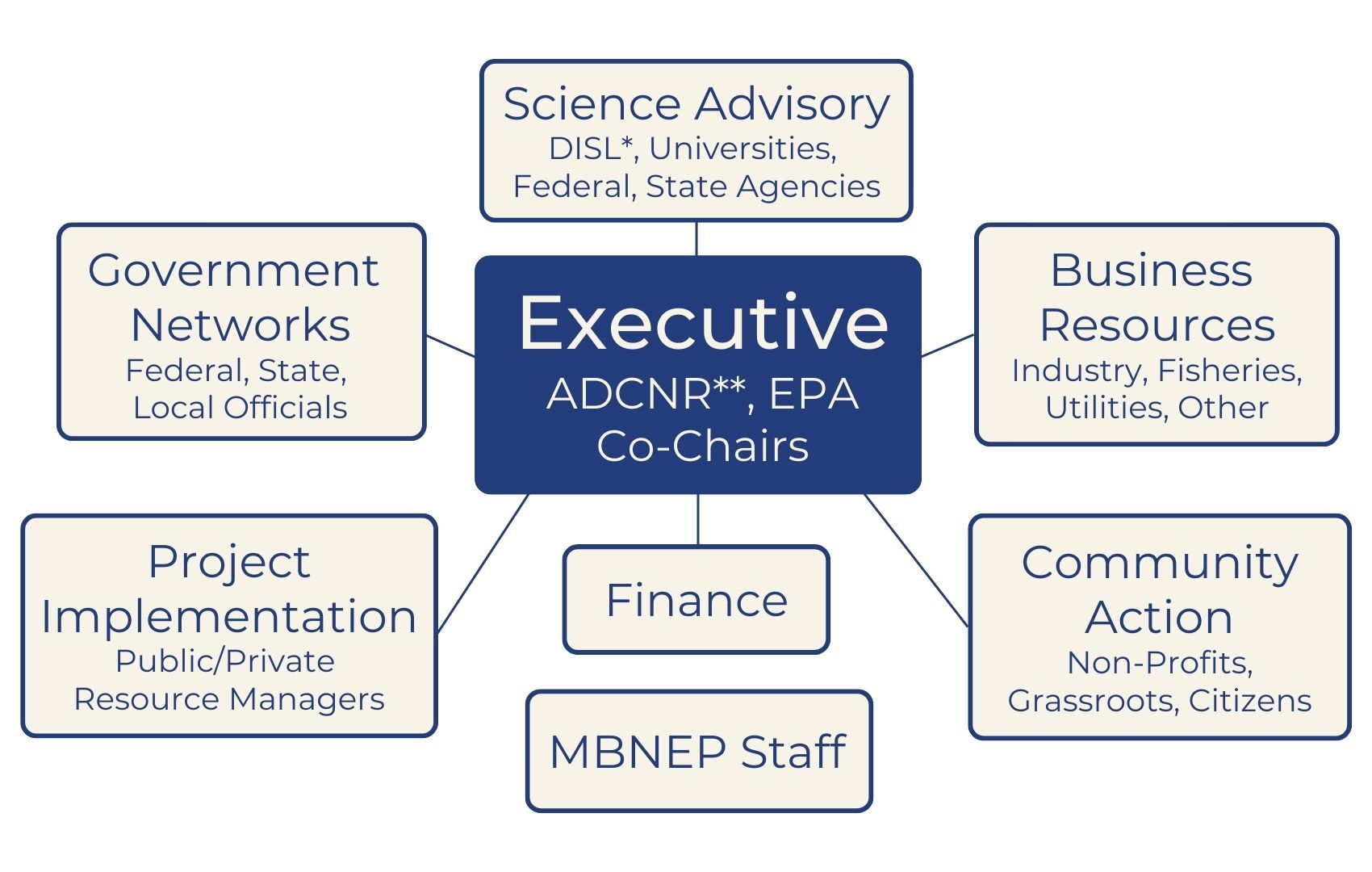Management Conference

*The Dauphin Island Sea Lab is the administrative host organization for the MBNEP and sits on the Science Advisory Committee
**The Commissioner of the Alabama Department of Conservation and Natural Resources along with an EPA representative are Co-Chairs of the Executive Committee
The Mobile Bay National Estuary Program is governed by a unique structure known as a Management Conference that serves as a platform for collective improvement and local control of the natural resource management of our Coast.
The Management Conference is composed of six groups of stakeholders and experts: the Science Advisory, Government Networks, Business Resources, Project Implementation, Community Action, and Finance Committees. The six committees are overseen by the Executive Committee, made up of leaders from each of the main committees as well as from the U.S. EPA and three at-large members. The Executive Committee develops policies on issues and funding, reviews/approves work plans and budgets, and sets financial goals for non-federal funding.
The Executive Committee
The Executive Committee (EC) is a volunteer, representative body of the Conference that provides general guidance, direction, and support for the MBNEP. The EC is tasked with 1) developing overall Bylaws for the Conference; 2) approving the CCMP, associated Work Plans for CCMP implementation, and official positions of the Conference; 3) providing a forum for the exchange of information (with committee Co-chairs providing a report of activities/issues at each meeting); and 4) appointing and charging Ad Hoc committees, as needed, based on recommendations from MBNEP personnel or committees.
The Government Networks Committee
The Government Networks Committee (GNC) brings together elected federal, state, and local public officials, as well as heads of federal and state agencies, and regional administrators or their representatives to educate about state priorities and programs; provides a venue for local officials to more effectively communicate local needs, and; improves government management of our coastal resources. The GNC is tasked with 1) identifying issues of common concern; 2) sharing information with constituencies about environmental needs; 3) affecting local policy changes; and 4) discussing how federal and state agencies and elected officials can work with local governments to cooperatively address local issues. The GNC may make recommendations to the EC about the CCMP and associated Work Plans.
The Businesses Resources Committee
The Business Resources Committee (BRC) brings together a diversity of interested business community leaders to identify common environmental concerns among sectors and ways of balancing different sector needs, and to identify coastal issues impacting their interests. The BRC is tasked with educating on issues related to quality of life, economic opportunities, land management, environmental responsibility, and balancing economic development with environmental sustainability. The BRC may make recommendations to the EC about the CCMP and associated Work Plans.
The Project Implementation Committee
The Project Implementation Committee (PIC) brings together resource management professionals to undertake environmental projects related to CCMP ecosystem restoration and protection goals and objectives. The PIC is tasked with 1) assessing restoration needs and resources, and prioritizing watershed projects, accordingly; 2) using watershed planning as a basis for conducting restoration activities; 3) identifying projects and planning for their implementation (e.g., habitat conservation, restoration and protection, access, etc.); and 4) conducting periodic project status meetings to track progress. The PIC may make recommendations to the EC about the CCMP and associated Work Plans.
The Science Advisory Committee
The Science Advisory Committee (SAC) brings together experts from various scientific disciplines to assess and communicate the health of the estuary and coastal resources; identifies areas of stress, data and data gaps, research and research gaps; and supports the Program Office with the best available science. The SAC is tasked with 1) assessing trends to determine where stresses are most acute in the system; 2) developing frameworks, monitoring protocols, and projects for measuring changes in ecosystem health; 3) providing technical advice and conducting scientific review of issues/activities requested by other committees; and 4) identifying opportunities for public participation and project involvement (e.g., citizen monitoring). The SAC may make recommendations to the EC about the CCMP and associated Work Plans.
The Community Action Committee
The Community Action Committee (CAC) brings together community grassroots environmental organizations for networking, information sharing, issues development, and cooperative training purposes. The CAC is tasked with 1) educating about the issues of the CCMP; and 2) educating about increased opportunities for public participation and project involvement. The CAC may make recommendations to the EC about the CCMP and associated Work Plans.
The Finance Committee
The Finance Committee (FC) develops local ownership, responsibility, and partnerships for investing in the long-term conservation and protection of coastal Alabama's estuarine resources by establishing an investment program that mixes state, local, and private sources to sustain the operations of the MBNEP. The FC is tasked with advising and assisting the MBNEP, as needed, on the development of its annual program budget and methodologies for obtaining match resources. The FC may make recommendations to the EC about the CCMP or associated Work Plans.




